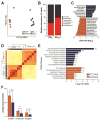Host Genotype and Gut Microbiome Modulate Insulin Secretion and Diet-Induced Metabolic Phenotypes
- PMID: 28199845
- PMCID: PMC5325228
- DOI: 10.1016/j.celrep.2017.01.062
Host Genotype and Gut Microbiome Modulate Insulin Secretion and Diet-Induced Metabolic Phenotypes
Abstract
Genetic variation drives phenotypic diversity and influences the predisposition to metabolic disease. Here, we characterize the metabolic phenotypes of eight genetically distinct inbred mouse strains in response to a high-fat/high-sucrose diet. We found significant variation in diabetes-related phenotypes and gut microbiota composition among the different mouse strains in response to the dietary challenge and identified taxa associated with these traits. Follow-up microbiota transplant experiments showed that altering the composition of the gut microbiota modifies strain-specific susceptibility to diet-induced metabolic disease. Animals harboring microbial communities with enhanced capacity for processing dietary sugars and for generating hydrophobic bile acids showed increased susceptibility to metabolic disease. Notably, differences in glucose-stimulated insulin secretion between different mouse strains were partially recapitulated via gut microbiota transfer. Our results suggest that the gut microbiome contributes to the genetic and phenotypic diversity observed among mouse strains and provide a link between the gut microbiome and insulin secretion.
Keywords: gut microbiome; insulin secretion; metabolic disease; pancreatic islets.
Copyright © 2017 The Author(s). Published by Elsevier Inc. All rights reserved.
Figures






Similar articles
-
The gut microbiota drives the impact of bile acids and fat source in diet on mouse metabolism.Microbiome. 2018 Aug 2;6(1):134. doi: 10.1186/s40168-018-0510-8. Microbiome. 2018. PMID: 30071904 Free PMC article.
-
Gut microbiota composition and its effects on obesity and insulin resistance.Curr Opin Clin Nutr Metab Care. 2014 Jul;17(4):312-8. doi: 10.1097/MCO.0000000000000067. Curr Opin Clin Nutr Metab Care. 2014. PMID: 24848531 Review.
-
Loss of angiopoietin-like 4 (ANGPTL4) in mice with diet-induced obesity uncouples visceral obesity from glucose intolerance partly via the gut microbiota.Diabetologia. 2018 Jun;61(6):1447-1458. doi: 10.1007/s00125-018-4583-5. Epub 2018 Mar 3. Diabetologia. 2018. PMID: 29502266 Free PMC article.
-
Bile acid is a significant host factor shaping the gut microbiome of diet-induced obese mice.BMC Biol. 2017 Dec 14;15(1):120. doi: 10.1186/s12915-017-0462-7. BMC Biol. 2017. PMID: 29241453 Free PMC article.
-
A review of metabolic potential of human gut microbiome in human nutrition.Arch Microbiol. 2018 Mar;200(2):203-217. doi: 10.1007/s00203-017-1459-x. Epub 2017 Nov 29. Arch Microbiol. 2018. PMID: 29188341 Review.
Cited by
-
Diabetes-associated alterations in the cecal microbiome and metabolome are independent of diet or environment in the UC Davis Type 2 Diabetes Mellitus Rat model.Am J Physiol Endocrinol Metab. 2018 Nov 1;315(5):E961-E972. doi: 10.1152/ajpendo.00203.2018. Epub 2018 Jul 17. Am J Physiol Endocrinol Metab. 2018. PMID: 30016149 Free PMC article.
-
Age-Related Differences in the Gut Microbiome of Rhesus Macaques.J Gerontol A Biol Sci Med Sci. 2020 Jun 18;75(7):1293-1298. doi: 10.1093/gerona/glaa048. J Gerontol A Biol Sci Med Sci. 2020. PMID: 32052009 Free PMC article.
-
Gut microbes and muscle function: can probiotics make our muscles stronger?J Cachexia Sarcopenia Muscle. 2022 Jun;13(3):1460-1476. doi: 10.1002/jcsm.12964. Epub 2022 Mar 12. J Cachexia Sarcopenia Muscle. 2022. PMID: 35278043 Free PMC article. Review.
-
Cluster partitions and fitness landscapes of the Drosophila fly microbiome.J Math Biol. 2019 Aug;79(3):861-899. doi: 10.1007/s00285-019-01381-0. Epub 2019 May 17. J Math Biol. 2019. PMID: 31101975 Free PMC article.
-
Novel regulators of islet function identified from genetic variation in mouse islet Ca2+ oscillations.Elife. 2023 Oct 3;12:RP88189. doi: 10.7554/eLife.88189. Elife. 2023. PMID: 37787501 Free PMC article.
References
Publication types
MeSH terms
Substances
Grants and funding
LinkOut - more resources
Full Text Sources
Other Literature Sources
Medical
Molecular Biology Databases

